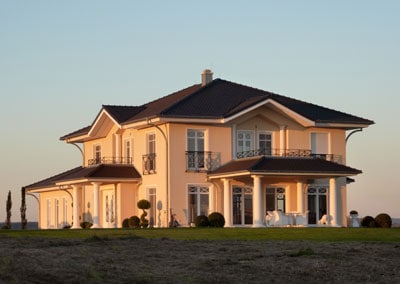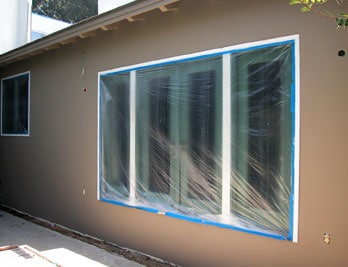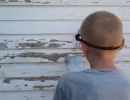[three_fourth]A helpful DIY guide on the best ways to paint stucco siding, including expert tips for paint preparation and the best painting techniques.
The beauty of stucco as a siding choice is that it already contains its finish color when applied, and the look usually lasts for years. Eventually, however, the surface can begin to show signs of age. If this happens, it’s time to paint it.
If you just want to give your house a color change for aesthetic reasons, keep in mind that once stucco is painted, the paint will need to be refreshed periodically. This means you’ll be buying-in to a major maintenance task every decade or so.
Paint Preparation
Like any surface, preparation before painting is the key. Stucco siding must be clean and free of cracks, holes, or other blemishes in order to achieve a good looking, lasting result.
To clean stucco that is sound, simply scrub it with a stiff nylon brush and detergent. If it has previously been painted and it has a smooth finish, you can scrape it with a wire brush or with a scraper.
The video below shows how to use masonry caulking compound to repair cracks. This video also does a really good job of showing how to use an airless sprayer to apply paint like a pro—more about painting later.
Before painting, apply a bead of caulking compound wherever stucco meets wood trim, such as where window trim meets the stucco or where the wall meets the soffit.
New paint may have trouble adhering to previously painted stucco. To give the surface some “tooth” for the new paint to grip, “scratch” the stucco with a wire brush.
If the previous paint is in serious disrepair, you may want to sandblast the surface to remove flaking paint. This should only be done by a professional. If you decide to go this route, be prepared for ear-numbing noise and a big mess of sand, dust, and flaked paint.
Do not pressure-wash the surface—this can damage the stucco.
If you notice patches that look like they have a white powder on them, see How to Fix Chalking Paint.
Right before you paint, protect windows, doors, fixtures, shrubs, and anything else that you don’t want painted by covering them with plastic sheeting and painter’s tape.
Painting Techniques
Apply either 100% acrylic latex paint or, if you’re willing to afford the expense, elastomeric paint, which is extremely durable. Many stucco painters recommend using a flat finish because it has a look that is most like the original stucco.
The easiest way to apply paint is to use an airless sprayer with a 24-inch extension wand. Set the sprayer’s pressure at 2200 p.s.i.
If you use a sprayer, you’ll get the best paint adhesion if you back-roll the freshly-applied wet paint with a 3/8-inch nap 9-inch roller. Be sure to back-roll immediately—before the paint dries. The video below shows how to do this.
Please note: Although the video below doesn’t show it, you should always wear an approved painting respirator when spray painting (here the helper should be wearing one, too). This video does a pretty good job of showing the technique of spraying and then back rolling.
Where the roller doesn’t reach, such as in corners, brush-in the paint with a wide nylon-bristle brush.










 Don Vandervort writes or edits every article at HomeTips. Don has:
Don Vandervort writes or edits every article at HomeTips. Don has:




